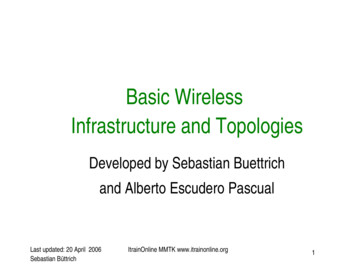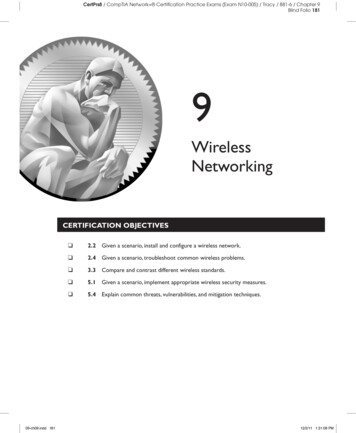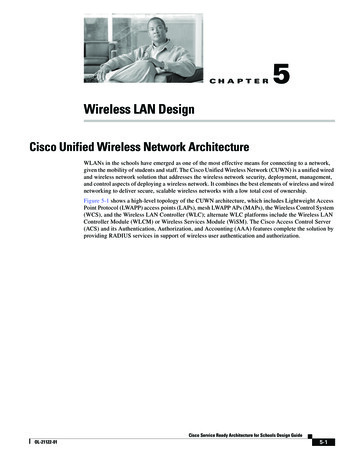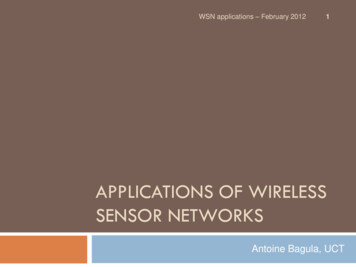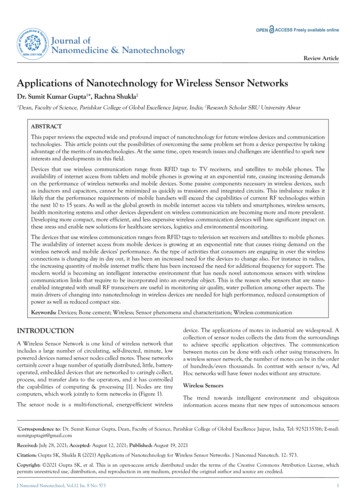
Transcription
ur nal of NanJoch nologoteyanedicine & NomISSN: 2157-7439OPENACCESS Freely available onlineJournal ofNanomedicine & NanotechnologyReview ArticleApplications of Nanotechnology for Wireless Sensor NetworksDr. Sumit Kumar Gupta1*, Rachna Shukla2Dean, Faculty of Science, Parishkar College of Global Excellence Jaipur, India; 2Research Scholar SRU University Alwar1ABSTRACTThis paper reviews the expected wide and profound impact of nanotechnology for future wireless devices and communicationtechnologies. This article points out the possibilities of overcoming the same problem set from a device perspective by takingadvantage of the merits of nanotechnologies. At the same time, open research issues and challenges are identified to spark newinterests and developments in this field.Devices that use wireless communication range from RFID tags to TV receivers, and satellites to mobile phones. Theavailability of internet access from tablets and mobile phones is growing at an exponential rate, causing increasing demandson the performance of wireless networks and mobile devices. Some passive components necessary in wireless devices, suchas inductors and capacitors, cannot be minimized as quickly as transistors and integrated circuits. This imbalance makes itlikely that the performance requirements of mobile handsets will exceed the capabilities of current RF technologies withinthe next 10 to 15 years. As well as the global growth in mobile internet access via tablets and smartphones, wireless sensors,health monitoring systems and other devices dependent on wireless communication are becoming more and more prevalent.Developing more compact, more efficient, and less expensive wireless communication devices will have significant impact onthese areas and enable new solutions for healthcare services, logistics and environmental monitoring.The devices that use wireless communication ranges from RFID tags to television set receivers and satellites to mobile phones.The availability of internet access from mobile devices is growing at an exponential rate that causes rising demand on thewireless network and mobile devices' performance. As the type of activities that consumers are engaging in over the wirelessconnections is changing day in day out, it has been an increased need for the devices to change also. For instance in radios,the increasing quantity of mobile internet traffic there has been increased the need for additional frequency for support. Themodern world is becoming an intelligent interactive environment that has needs novel autonomous sensors with wirelesscommunication links that require to be incorporated into an everyday object. This is the reason why sensors that are nanoenabled integrated with small RF transceivers are useful in monitoring air quality, water pollution among other aspects. Themain drivers of changing into nanotechnology in wireless devices are needed for high performance, reduced consumption ofpower as well as reduced compact size.Keywords: Devices; Bone cement; Wireless; Sensor phenomena and characterization; Wireless communicationINTRODUCTIONA Wireless Sensor Network is one kind of wireless network thatincludes a large number of circulating, self-directed, minute, lowpowered devices named sensor nodes called motes. These networkscertainly cover a huge number of spatially distributed, little, batteryoperated, embedded devices that are networked to caringly collect,process, and transfer data to the operators, and it has controlledthe capabilities of computing & processing [1]. Nodes are tinycomputers, which work jointly to form networks in (Figure 1).The sensor node is a multi-functional, energy-efficient wirelessdevice. The applications of motes in industrial are widespread. Acollection of sensor nodes collects the data from the surroundingsto achieve specific application objectives. The communicationbetween motes can be done with each other using transceivers. Ina wireless sensor network, the number of motes can be in the orderof hundreds/even thousands. In contrast with sensor n/ws, AdHoc networks will have fewer nodes without any structure.Wireless SensorsThe trend towards intelligent environment and ubiquitousinformation access means that new types of autonomous sensors*Correspondence to: Dr. Sumit Kumar Gupta, Dean, Faculty of Science, Parishkar College of Global Excellence Jaipur, India, Tel: 9252135316; E-mail:sumitguptagit@gmail.comReceived: July 28, 2021; Accepted: August 12, 2021; Published: August 19, 2021Citation: Gupta SK, Shukla R (2021) Applications of Nanotechnology for Wireless Sensor Networks. J Nanomed Nanotech. 12: 573.Copyright: 2021 Gupta SK, et al. This is an open-access article distributed under the terms of the Creative Commons Attribution License, whichpermits unrestricted use, distribution, and reproduction in any medium, provided the original author and source are credited.J Nanomed Nanotechnol, Vol.12 Iss. 8 No: 5731
Gupta SK, et al.OPENACCESS Freely available onlineenough. Furthermore, the future embedded sensors need to beso inexpensive and ecologically sustainable that they can be usedin very large numbers. Driver for nanotechnologies in sensors isnot primarily miniaturization. The size of the sensor depends onmeasurement itself,WIRELESSSENSORTOPOLOGIESNETWORKS(WSN)There are four common sensor network topologies:Figure 1: A Wireless sensor networkwith wireless communication links will be embedded in everydayobjects. The devices must be small, cheap and capable of operatingwith power supplied by a very small battery, or electricity harvestedfrom light, radio waves or thermal energy [2]. New nano-enabledsensors combined with miniaturized RF transceivers can be usedfor health monitoring devices, and monitoring of air quality,soil or water pollution. RFID tags are very simple, usually passivedevices, which can be read using a radio frequency trans ceiver.Fabrication by printing can reduce the costs of wireless sensorscosts substantially, and nanoparticle inks can be used to increasethe performance of the printed devicesChallengesKey drivers for using nanotechnology in wireless communicationscome from improved performance, smaller power consumption,smaller size and new features such as flexibility or transparency.Some of these are already proven to be technologically feasible, butmany technological difficulties are still unsolved. Cost reductionis an important driver: new technologies will not gain marketshare until they become cost competitive with existing solutions[3]. The barriers of commercialisation of new technologies for RFelectronics are less severe than in digital electronics, since there is aclear need for replacement technologies.SENSORS AND SENSING EVERYWHEREMicromechanical sensors became an elementary part of automotivetechnologies in mid-1990, roughly ten years later more miniaturizedmicromechanical sensors are enabling novel features for consumerelectronics and mobile devices. Within next ten years thedevelopment of truly embedded sensors based on nanostructureswill become a part of our everyday intelligent environments.Nanotechnologies may also augment the sensory skills of humansbased on wearable or embedded sensors and the capabilitiesto aggregate this immense global sensory data into meaningfulinformation for our everyday life. This requires novel technologiesand cross-disciplinary research in many ways [4,5]. Embeddingintelligent and autonomous devices into physical objects of theworld requires that devices adapt to their environment and becomea part of the network of devices surrounding them. There is noway to configure this kind of a huge system manually–top down.Nanotechnology can help to develop novel kind of intelligentdevices where learning is one of the key characteristic propertiesof the system, similarly to biological systems which grow andadapt to the environment autonomously. Nanotechnologies mayopen solutions for sensors that are robust in harsh environmentalconditions and that are stable over long period of time. Todaymechanical sensors – pressure and acceleration sensors – arealready demonstrated to fulfil these requirements, but we do nothave chemical or biochemical sensors that are stable or robustJ Nanomed Nanotechnol, Vol.12 Iss. 8 No: 5731. Point to point network2. Star network3. Tree network4. Mesh networkWe will discuss each of them briefly.1. Point to Point Netwrok TopologyIn this topology, there is no central hub. A node can communicatedirectly to another node. This is the most common topology andit has a single data communication channel which offers a securecommunication path. Each device can act as a client and a serverin it (Figure 2).2. Star Netwrok TopologyUnlike point to point networks, a centralized communication hubis present in a star network. Each communication is done throughthis centralized hub and no direct communications between thenodes are possible. In this case, central hub is the server and thenodes are clients (Figure 3).3. Tree Network TopologyThis topology is said to be a hybrid of point to point and startopologies. The central hub in it is called a root node or the parentnode. Data is passed on from leaf nodes to the parent node. Themain advantage of this topology is less power consumption ascompared to other networks (Figure 4).4. Mesh Network TopologyIn the mesh network, the data can ‘hop’ from one node to another.Figure 2: A Wireless sensor network.Figure 3: Star network topology.2
Gupta SK, et al.OPENACCESS Freely available onlineto the underwater communication system. The battery of theseWSNs is also limited and cannot be recharged; therefore, differenttechniques are being developed to solve this issue of energy usageand conservation (Figure 7).4. Multimedia WSNsFigure 4: Tree network topology.All the nodes can communicate with each other directly withouthaving to depend on a central communication hub. This is themost reliable structure of network communication because thereis no single point of failure in it. But this structure is very complexand requires a lot of power consumption (Figure 5).These sensor networks can gather information in the form ofaudio, video and imaging. The sensor nodes in these networks areconnected with cameras and microphones. They can track andmonitor different events occurring and can keep a visual display ofthe events also. For the purpose of data compression, retrieval andcorrelation, these nodes are also interconnected with one anotherthrough a wireless connection (Figure 8).As audio and visual data can also be transmitted through thesenetworks therefore they require high consumption of power andhigh bandwidth. Advanced techniques of data processing andcompression are used in it.Figure 5: Mesh network topology.TYPES OF WIRELESS SENSOR NETWORKSThere are different types of sensor networks such as underground,underwater, terrestrial and multimedia WSNs etc. We will discussthem briefly.1. Terrestrial WSNsFigure 6: Problems are faced while recharging the batteries of theunderground sensor networks and loss of signal can also occur due to highlevel of attenuation in the underground environment.These types of networks consist of hundreds or thousands of wirelesssensor nodes. These nodes can be deployed in an unstructured ora structured manner. The nodes are distributed randomly in anunstructured mode, but they are kept within the target area.As these are the ‘terrestrial’ sensor networks therefore theyare above ground and solar cells can be used to power up thesenetworks. The energy can be conserved by minimizing delays andby using operations of low duty cycles etc.2. Underground WSNsThese sensor networks are more costly as compared to terrestrialnetworks. The equipment’s used are expensive and propermaintenance is needed. These are effectively used to monitorthe underground conditions therefore their whole network isunderground but to pass on the information to the base station,sink nodes are used which are present above the ground (Figure 6).Figure 7: Under water sensors.Problems are faced while recharging the batteries of theunderground sensor networks and loss of signal can also occur dueto high level of attenuation in the underground environment.3. Underwater WSNsUnderwater wireless sensor network system comprises of sensornodes and vehicles which are deployed under the water. To gatherdata from the sensor nodes, underwater vehicles are to be used.The long propagation delay and sensor failures are a big challengeJ Nanomed Nanotechnol, Vol.12 Iss. 8 No: 573Figure 8: Multimedia WSNs.3
Gupta SK, et al.OPEN5. Mobile WSNsThe mobile network, as the name suggests, is not fixed rather thesensor nodes can move from one place to any other. They can beeasily interfaced with the environment around them. Their mainadvantage is that they provide better coverage, superior channelcapacity and enhanced coverage. These mobile WSNs are moreversatile as compared to the other static sensor network systems.APPLICATIONSNETWORKSOFWIRELESSSENSORThere are numerous applications of WSNs in industrial automation,traffic monitoring and control, medical device monitoring and inmany other areas. Some of applications are discussed below:1. Disaster Relief OperationIf an area is reported to have been stricken from some sort ofcalamity such as wildfire, then drop the sensor nodes on the firefrom an aircraft. Monitor the data of each node and construct atemperature map to devise proper ways and techniques to overcomethe fire (Figure 9).2. Military ApplicationsAs the WSNs can be deployed rapidly and are self-organizedtherefore they are very useful in military operations for sensing andmonitoring friendly or hostile motions. The battlefield surveillancecan be done through the sensor nodes to keep a check on everythingin case more equipment, forces or ammunitions are needed in thebattlefield. The chemical, nuclear and biological attacks can also bedetected through the sensor nodes (Figure 10).ACCESS Freely available onlineenvironment. They can be used to track movement of animals,birds and record them. Monitoring of earth, soil, atmospherecontext, irrigation and precision agriculture can be done throughthese sensors. They can also use for the detection of fire, flood,earthquakes, and chemical/biological outbreak etc (Figure 11).A common example is of ‘Zebra Net’. The purpose of this systemis to track and monitor the movements and interactions of zebraswithin themselves and with other species also.4. Medical ApplicationsIn health applications, the integrated monitoring of a patient canbe done by using WSNs. The internal processes and movementsof animals can be monitored. Diagnostics can be done. They alsohelp in keeping a check on drug administration in hospitals and inmonitoring patients as well as doctors.An example of this is ‘artificial retina’ which helps the patient indetecting the presence of light and the movement of objects. Theycan also locate objects and count individual items.5. Home ApplicationsAs the technology is advancing, it is also making its way in ourhousehold appliances for their smooth running and satisfactoryperformance. These sensors can be found in refrigerators,microwave ovens, vacuum cleaners, security systems and also inwater monitoring systems. The user can control devices locally aswell as remotely with the help of the WSNs (Figure 12).An example of this is the ‘sniper detection system’ which can detectthe incoming fire through acoustic sensors and the position of theshooter can also be estimated by processing the detected audiofrom the microphone.3. Environmental ApplicationsThese sensor networks have a huge number of applications in theFigure 11: Environmental applications.Figure 9: Disaster relief operation.Figure 12: Home applications.CONCLUSIONSFigure 10: Military applications.J Nanomed Nanotechnol, Vol.12 Iss. 8 No: 573The use of wireless communication systems is increasing very rapidly.Key drivers for using nanotechnology in wireless communicationsare improved performance, smaller power consumption, smallersize and new features. Current RF technologies for high datarate communication systems are expected to be capable of4
Gupta SK, et al.meeting the industry needs for the next 1015 years, but after thatfundamental physical limits of the radio electronics will start tohinder the development [6-9]. New solutions are needed, butthey are still in the research phase. Wireless sensors and sensornetworks have applications in logistics, security systems, and healthand environment monitoring. The main societal concerns forubiquitous information access and sensors networks arise fromsecurity and privacy issues, as well as environ mental aspects fordisposable sensors.REFERENCES1. Sazonova V, Yaish Y, Ustünel H, Roundy D, Arias TA, McEuen P etal. A tunable carbon nanotube electromechanical oscillator. Nature.October 2004; 43:284-287.2. She JPM, Yeow JTW. Nanotechnology-Enabled Wireless SensorNetworks: Overcoming the Limitations from a Device Perspective inProceedings of the IEEE International Conference on Mechatronicsand Automation. Niagara Falls. Canada, 2005.J Nanomed Nanotechnol, Vol.12 Iss. 8 No: 573OPENACCESS Freely available online3. Pendry J, Shurig D, Smith D. Controlling electromagnetic fields.Science. 2019; 312(2):1780-1782.4. International Technology Roadmap for Semiconductors. EmergingResearch Devices. 2005 Edition.5. Snider G. S, Williams R. S. Nano/CMOS architectures using a Fieldprogrammable nanowire interconnect. Nanotechnology. 2017;18:1-11.6. Wolf S. A. Spintronics: A Spin-Based Electronics Vision for theFuture. Science. 2001; 294:1488–1495.7. Imre A, Csaba G, Ji L, Orlov A, Bernstein G. H, Porod W et al.Majority Logic Gate for Magnetic Quantum-Dot Cellular Automata.Science. 2006; 311:205-208.8. Dalton A, Collins S, Razal J, Munoz E, Von Howard E, Kim B et al.Super-tough carbon-nanotube fibers. Nature. 2011; 423:703.9. Ma M, Hill MR. Super hydrophobic surfaces. Curr Opin ColloidInterface Sci. 2006; 11:193–202.5
with wireless communication links will be embedded in everyday objects. The devices must be small, cheap and capable of operating with power supplied by a very small battery, or electricity harvested from l




